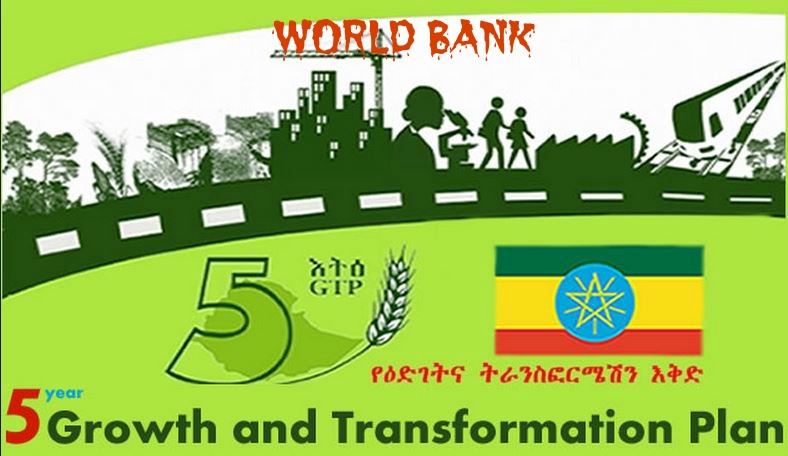 The World Bank lies, Ethiopia dies… from onerous “odious debt”
The World Bank lies, Ethiopia dies… from onerous “odious debt”
I had completely forgotten about the so-called “Growth and Transformation Plan” (GTP) of 2010, until the World Bank reminded me of it last week.
That “Plan” was the late Meles Zenawi’s gimmick about having an economic plan for Ethiopia. In 2010, Meles made the ridiculous claim that as a result of his GTP “Ethiopian economic growth may average 14.9 percent annually over the next five years [2010-15].” His contempt for our intelligence was surpassed only by our contempt for his ignorance. His mantra was, “No one ever went broke underestimating the intelligence of the Ethiopian people.”
Last week, the World Bank issued a “Featured Story” entitled, “Can Ethiopia’s Resource Wealth Contribute to its Growth and Transformation?”. The Bank claimed, “Ethiopia has averaged a 10.7% economic growth rate over the last 10 years, more than double the annual average of countries in Sub-Saharan Africa, which was around 5.2%.” The World Bank’s contempt for our intelligence is exceeded only by Meles’.
The same claptrap was even repeated by President Barack Obama on September 25, 2014 when he declared, “there is no better example of progress in Africa than what has been happening in Ethiopia — one of the fastest-growing economies in the world.” Was Obama merely parroting an obligatory complement?
Last week, I published my commentary, “World Bank-ruptcy in Ethiopia”. Two weeks ago, the World Bank’s Inspection Panel (IP) Report (prepared in November 2014 for limited circulation to the Bank’s top brass) on the impact of the so-called “Protection of Basic Services Project” (PBS III) on the “villagization” of the Anuak People in Western Ethiopia was mysteriously posted on line. The IP Report showed the World Bank has been playing a cruel bureaucratic joke on Ethiopians and engaged in an elaborate game of deception in its implementation of its PBS III. (Incidentally, and possibly coincidentally, the World Bank’s “Featured Story” on “Ethiopia’s Growth and Transformation” was released on the same day I posted my “World Bank-ruptcy” commentary.
Last week, I also read the World Bank’s 189-page report entitled, “Ethiopia Poverty Assessment” released on January 20, 2015. The “Assessment” proclaimed, “Poverty in Ethiopia fell from 44 percent in 2000 to 30 percent in 2011, which translated to a 33 percent reduction in the share of people living in poverty. This decline was underpinned by high and consistent economic growth.” (Presumably it dropped from 30 percent to 0 percent between 2012 and 2015.)
What a colossal waste of time reading such a crock! (I should have used the time to finish reading the learned commentaries of Nubre Ed Ermias Kebede Wolde-Yesus in “Ethiopia: YeAlemu Mefarejia” (“Ethiopia: On Judgment Day” [my translation of the title]).
“Houston, we’ve got a problem,” reported the crew of Apollo 13 to describe the crises in Mission Control. I say, “Fellow Ethiopians, we’ve got a problem here!” What exactly is the truth about Ethiopia economic growth rate and development? Did Ethiopia really average “10.7 percent annual growth over the last 10 years”? What is the proof for such a claim? Is it even remotely possible that Ethiopia could have “averaged 14.9 percent annually” during the 2010-2015 period as Meles claimed? Does it even make common sense to claim with a straight face that the “second poorest country in the world” has been growing its economy by 11 to possibly 15 percent a year for a decade and half? Where does the World Bank get its statistics on Ethiopia’s economic growth?
Why is the World Bank publicizing figures its knows are manifestly highly dubious and outright boldfaced lies? Is it to impress the Ethiopian public by extolling the skillful management of the Ethiopian economy by the Thugtatorship of the Tigrean Peoples Liberation Front (T-TPLF)? Is it intended to be a self-congratulatory pat on the back for the donors and loaners and prove to the world that they played a central and decisive role in lifting out of poverty and transforming a once famine-stricken country into a shining example of loan- and aid-based development (an oxymoronic claim on its face)?
Could it be part of a larger deception games perpetrated on the Ethiopian people? Was President Obama merely repeating what his aides told him when he said “there is no better example of progress in Africa” than Ethiopia? Or does he know as much about the Ethiopian economy as he said he “knows” about Ethiopia’s elections?
If Ethiopia is the shining example of economic growth in Africa, “why is Ethiopia the second poorest country on the planet? (For the answer, read my June 2014 commentary by the same title.)
Joseph Goebbels, history’s most infamous propagandist, observed, “If you tell a lie big enough and keep repeating it, people will eventually come to believe it.”
When that big lie is repeated by the biggest leader in the world and trumpted by the mighty World Bank, it has the potential to become a little big truth. But a lie however big could never become even a small truth; wrong does not become right because the high and mighty said so; nor does evil become good even when wrapped in a golden robe. A lie will forever be a lie even if it is accepted as truth by the majority.
I will readily admit there has been an 11 percent, even 15 percent, annual growth in mushrooming lies, proliferation of damned lies and procreation and propagation of statislies by the T-TPLF and its toady loaners and donors.
How the World Bank uses lies, damned lies and statistics to lie (“statislying”)